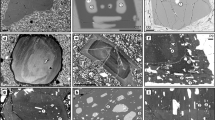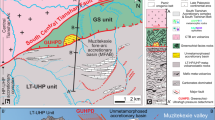Abstract
The Moon is thought to have formed through the consolidation of debris from the collision of a Mars-sized body with the Earth more than 4,500 million years ago. The primitive Moon was covered with a thick layer of melt known as the lunar magma ocean1, the crystallization of which resulted in the Moon’s surface as it is observed today. There is considerable debate, however, over the precise timing and duration of the process of magma ocean crystallization. Here we date a zircon from lunar breccias to an age of 4,417±6 million years. This date provides a precise younger age limit for the solidification of the lunar magma ocean. We propose a model that suggests an exponential rate of lunar crystallization, based on a combination of this oldest known lunar zircon and the age of the Moon-forming giant impact. We conclude that the formation of the Moon’s anorthositic crust followed the solidification of 80–85% of the original melt, within about 100 million years of the collision. The existence of younger zircons2 is indicative of the continued solidification of a small percentage of melt for an extra 200–400 million years.
This is a preview of subscription content, access via your institution
Access options
Subscribe to this journal
Receive 12 print issues and online access
$259.00 per year
only $21.58 per issue
Buy this article
- Purchase on Springer Link
- Instant access to full article PDF
Prices may be subject to local taxes which are calculated during checkout



Similar content being viewed by others
References
Shearer, C. K. Thermal and magmatic evolution of the moon. In: New Views of the Moon, Rev. Mineral. Geochem. 60, 365–518 (Mineralogica Society of America, 2006).
Nemchin, A. A., Pidgeon, R. T., Whitehouse, M. J., Vaughan, J. P. & Meyer, C. SIMS U–Pb study of zircon from Apollo 14 and 17 breccias: Implications for the evolution of lunar KREEP. Geochim. Cosmochim. Acta. 72, 668–689 (2008).
Warren, P. H. & Wasson, J. T. The origin of KREEP. Rev. Geophys. Space Phys. 17, 73–88 (1979).
Alibert, C., Norman, M. D. & McCulloch, M. T. An ancient Sm–Nd age for a ferroan noritic anorthosite clast from lunar breccia 67016. Geochim. Cosmochim. Acta 58, 2921–2926 (1994).
Borg, L. Isotopic studies of ferroan anorthosite 62236: A young lunar crustal rock from a light rare-earth-element-depleted source. Geochim. Cosmochim. Acta 63, 2679–2691 (1999).
Norman, M. D., Borg, L. E., Nyquist, L. E. & Bogard, D. D. Chronology, geochemistry, and petrology of a ferroan noritic anorthosite from Descartes breccia 67215: Clues to the age, origin, structure and impact history of the lunar crust. Meteorit. Planet. Sci. 38, 645–661 (2003).
Papanastassiou, D. A., Wasserburg, G. J. & Burnett, D. S. Rb–Sr ages of lunar rocks from the Sea of Tranquillity. Earth Planet. Sci. Lett. 8, 1–19 (1970).
Tera, F. & Wasserburg, G. U–Th–Pb systematics on lunar rocks and inferences about lunar evolution and the age of the moon. Proc. 5th Lunar Sci. Conf. 1571–1599 (1974).
Lugmair, G. W. & Carlson, R. W. The Sm–Nd history of KREEP. Proc. Lunar Planet. Sci. Conf. 9, 689–704 (1978).
Nyquist, L. E. & Shih, C.-Y. The isotopic record of lunar volcanism. Geochim. Cosmochim. Acta 56, 2213–2234 (1992).
Touboul, M., Kleine, T., Bourdon, B., Palme, H. & Wieler, R. Late formation and prolonged differentiation of the Moon inferred from W isotopes in lunar metals. Nature 450, 1206–1209 (2007).
Nyquist, L. E., Wiesmann, H., Shih, C.-Y., Keith, J. E. & Harper, C. L. 146Sm–142Nd formation interval in the lunar mantle. Geochim. Cosmochim. Acta 59, 2817–2837 (1995).
Rankenburg, K., Brandon, A. D. & Neal, C. Neodymium isotope evidence for the chondritic composition of the Moon. Science 312, 1369–1372 (2006).
Compston, W., Williams, I. S. & Meyer, C. U–Pb geochronology of zircons from Lunar Breccia 73217 using a sensitive high mass-resolution ion microprobe, Proc. Lunar Planet. Sci. Conf. 14th, J. Geophys. Res. 89, B525–B534 (1984).
Dickinson, J. E. & Hess, P. C. Zircon saturation in lunar basalts and granites. Earth Planet. Sci. Lett. 57, 336–344 (1982).
Timms, N. E., Kinny, P. D. & Reddy, S. M. Enhanced diffusion of Uranium and Thorium linked to crystal plasticity in zircon. Geochem. Trans. 7, 10 (2006).
Reddy, S. M. et al. Crystal-plastic deformation of zircon: A defect in the assumption of chemical robustness. Geology 34, 257–260 (2006).
Solomatov, V. S. in Origin of the Earth and Moon (eds Canup, R. & Righter, K.) 323–338 (Univ. Arizona Press, 2000).
Snyder, G. A., Taylor, L. A. & Neil, C. R. A chemical model for generating the sources of mare basalts: Combined equilibrium and fractional crystallization of the lunar magmasphere. Geochim. Cosmochim. Acta 56, 3809–3823 (1992).
Longhi, J. A model of early lunar differentiation. Proc. Lunar Planet. Sci. Conf. 11, 289–315 (1980).
Reddy, S. M., Timms, N. E., Pantleon, W. & Trimby, P. Quantitative characterization of plastic deformation of zircon and geological implications. Contrib. Mineral. Petrol. 153, 625–645 (2007).
Acknowledgements
In particular we would like to thank the astronauts of Apollo 17 for collecting the sample. The project was supported by the office of R&D department at Curtin University of Technology. Imaging was supported by the Australian Research Council Discovery Grant DP0664078 to S.R. and N.T.
Author information
Authors and Affiliations
Corresponding author
Supplementary information
Supplementary Information, Table S1
Supplementary Information (PDF 120 kb)
Rights and permissions
About this article
Cite this article
Nemchin, A., Timms, N., Pidgeon, R. et al. Timing of crystallization of the lunar magma ocean constrained by the oldest zircon. Nature Geosci 2, 133–136 (2009). https://doi.org/10.1038/ngeo417
Received:
Accepted:
Published:
Issue Date:
DOI: https://doi.org/10.1038/ngeo417
This article is cited by
-
Moon’s high-energy giant-impact origin and differentiation timeline inferred from Ca and Mg stable isotopes
Communications Earth & Environment (2023)
-
The accretion of planet Earth
Nature Reviews Earth & Environment (2022)
-
Phase transition and melting in zircon by nanosecond shock loading
Physics and Chemistry of Minerals (2022)
-
Redox-dependent Ti stable isotope fractionation on the Moon: implications for current lunar magma ocean models
Contributions to Mineralogy and Petrology (2022)



